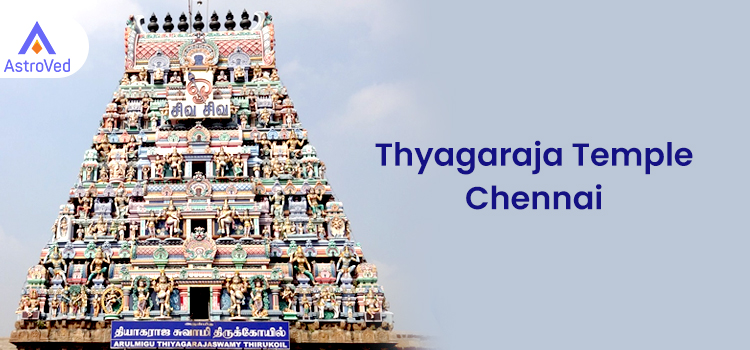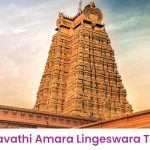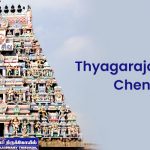Thyagaraja Temple (also called Vadivudai Amman Temple) is dedicated to Lord Shiva or Adipurishwarar. It is in Tiruvottiyur, north Chennai, Tamil Nadu. The temple finds mention in the Thevaram hymns of the Shaiva Nayanars, Tamil saint poets who lived during the 7th century. It is also a Paadal Petra Sthalam. Appar, Sambandhar, and Sundarar have rendered Thevaram songs here. The temple has close associations with Sundarar and Pattinathar.
The temple has been existing since the Pallava period (7th century). It saw expansion during the reign of the Chola kings in the 11th century. It has a seven-tiered gateway tower and a tank and encompasses an area of 1 acre. In the 15th century, the Vijayanagara rulers expanded it further.
The temple is similar to the Thygaraja temple in Tiruvarur as both were expanded by Rajendra Chola I and they also feature the same dance poses of Shiva. Though the temple’s presiding deity is Adipuriswarar, the temple is closely associated with the Thyagaraja cult of Shaivism. Somaskanda, the iconic form of Thyagaraja, supposedly emerged in the 10th century during the rule of Raja Raja Chola. Sundarar supposedly spread the cult from Tiruvarur to this temple. The story goes that the deity tricked him by making him promise that he would never leave Tiruvottriyur. However, he broke his vow and became blind.
Legend of the Thyagaraja Temple
There are many legends around the Thyagaraja Temple in Tiruvottiyur.
Lord Brahma, the god of creation and one of the Hindu trinity, created the Devas (gods), Asuras (demons), and Daityas. The gods and demons fought each other constantly. While the demons used their brute strength, the gods used the power of the Vedas, the sacred Hindu texts, to overcome them. Once, two demons called Madhu and Kaithaba stole the Vedas, chopped them into pieces, and hid them in the bottom of the sea. Though Vishnu fought the demons, he could not defeat them. Then, he prayed to Shiva and Parvati and managed to defeat the demons. Taking the form of Matsya, a huge fish, he was able to dive into the ocean and recover the Vedas from the bottom of the sea. As per legend, the deity at this temple put the Vedas in order and purified them. The wishing tree of the gods, called the makizha tree, became the sacred tree of this temple.
Another legend claims that Shiva took the form of a huge fire to make flood waters recede. Hence, this place got the name Thiru Otriyur (“votra” or “vatra” means ‘receding water’ in Tamil). It’s also believed that he stayed here as a Swayambu lingam beneath a Makizha tree. It was the first Swayambu lingam that appeared on earth after the raging floods. For this reason, devotees refer to Shiva here as Adipuriswarar (‘Adi’ means ‘first’, in Tamil).
Temple History
Thyagaraja temple was a renowned center of learning, and the temple halls served as venues for religious discourses. A hermitage was attached to the temple during the 9th century, and Caturananas Pandithar presided over it.
There are several inscriptions in the temple going back to the Pallava period. Adi Sankaracharya supposedly visited the temple to subdue the power of evil. Built by the Pallavas originally, the temple was later rebuilt by Rajendra Chola I.
During the reign of Malik Kafur, the temple was heavily damaged. The bronze idols found in the temple now were installed during the Vijayanagara period in the 15th century. A 13th-century inscription hints at animal sacrifice to the goddess and offerings of intoxicating drinks, which continued till the early 2000s.
The temple has two shrines for the Lord – one for Adipuriswarar and the other for Otreeswarar. He is present as a Swayambu lingam as an ant hill in the main sanctum. Vishnu is on his right, while Brahma is on the left.
The presiding deity here is Adipureeswarar, who is in the form of a mud mound covered by armor. On the full moon day of the Tamil month Karthigai, the armor is removed, and the deity becomes visible to devotees. One can see a Durga shrine on the northern side of the temple. There is a Nataraja shrine inside the main temple complex, opposite the main shrine. In the koshta is the Ganapati shrine. Ganapati here is Gunalaya Ganapati (abode of bliss). The idol of Adi Shankara is just behind the main shrine inside the complex. Subrahmanya is also present here. A statue of Dakshinamurthy is in the northern koshta facing south. A shrine for Kali is also present here. Adi Shankara supposedly installed a chakra to calm down the goddess and make her Sowmya roopi. Even now, a few Nampoothiri families perform the Pooja and Aradhana to the Lord and Goddess as Adi Shankara had desired.
The goddess here is called Vadivudaiamman alias Tripurasundari. She is in a separate shrine inside the temple complex. This temple is one of the Sakthi triad in the Tondaimandalam region. The other two are the Kodiyidai Amman Temple or Masilamaniswara Temple at Thirumullaivoyal and the Thiruvudai Amman
Temple or Thirumanangeeswarar Temple at Minjur.
Thiruvudai Amman is also known as Ichcha Shakthi, the goddess who grants devotees’ wishes. Vadivudai Amman is Gnana Shakti, the goddess who bestows gnana or knowledge. Kodiyidai Ammam is Kriya Shakti, the goddess who helps one in all actions.
Other deities in the temple include Thiruvotrieswarar, Agasalingam, Thiruputheeswarar, Kuzhandhai Eesar, Kalyana Sundarar, Jagannadhar, Annamalayar, Jambukeswarar, Ramanathar, Suryan, Chandran, Nalvars, Meenakshi, Nagalingar, Sundareswarar, Sahasralingam, Gowlieeswarar, Amirthakandeesar, Ekapaadhar, Gunalaya Vinayagar, Aruljothi Murugan, Valar Kali. The twenty-seven Nakshatras, or stars of the Tamil calendar, worshipped Shiva here.
History of Thyagaraja Temple
Thyagaraja Temple’s history dates back to the 7th century when the Pallava kings held sway. They built the temple, but later, in the 11th century, the Cholas renovated and rebuilt it. During the Vijayanagara period of the 15th century, it was further renovated and expanded.
The temple was a great center of learning. The Mandapams served as venues for various religious courses. Symposiums were also held often.
Temple Festivals
Brahmotsavam, the main festival, takes place over 10 days during the Tamil month of Maasi (February–March). On the eighth day, there is an additional function called Mahiladisevai. Durga’s shrine is associated with Kannagi, the heroine of Silappadikaram, a 2nd-century Tamil epic. Every year, a 15-day festival is celebrated to honor Durga. On the final day, the thatched roof of the structure where the event takes place is burnt to symbolize Kannagi’s burning of Madurai.
Maha Shivaratri, Arudhra Darshan, Pradoshams, Navratri, Skanda Shasti, Aadi Pooram, Pournami, Maasi Brahmotsavam, Vasantha Urchavam, Thai Poosam, Vattaparaiamman Urchavam, and Pattinathar Guru Poojai are celebrated grandly every year.
Benefits of Worshipping at the Temple
Devotees visit the Thyagaraja Swamy Temple to pray for the welfare of their children. Many believe the temple has healing powers and can cure their ailments.
People perform Mukundarchana to the deity for success in life. Some offer Milagu (pepper) rasam to Juradevar for relief from high fever.
Milk Rice Neivedhyam to the Goddess on Purattasi Navami can bestow salvation. Worshipping Thyagarajar can bestow a happy life, marriage and progeny blessings, good education, jobs, and promotions.
Temple Timings
Morning: 6 am to 12 pm
Evening: 4 pm to 8.30 pm
How to Reach
By Air
Chennai International Airport and Chennai Domestic Airport are at a distance of 30 km from the temple.
By Train
Chennai Central Station is 10 km away, and Tiruvottiyur railway station, the nearest train station, is 2 km away.
By Road
There are many private and Government buses, cabs, and autos to reach Thyagaraja Temple from various places. Theradi bus stop, less than a kilometer away, is the nearest.


